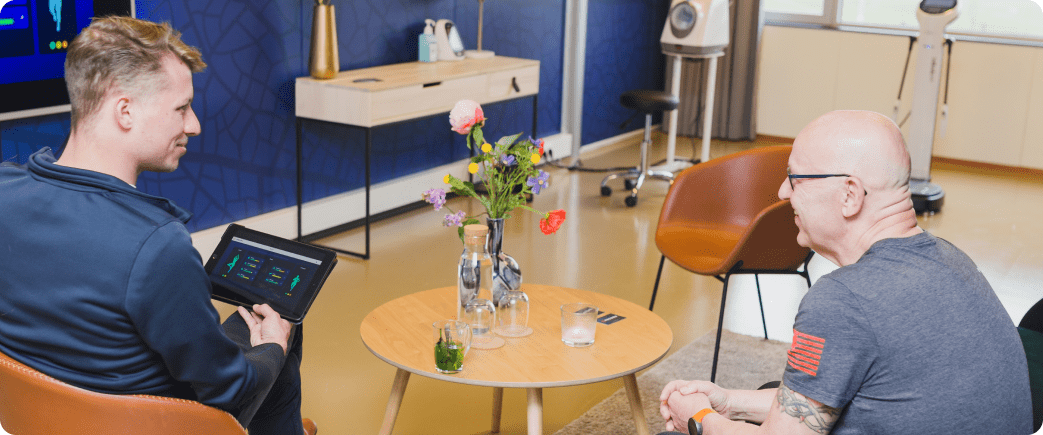22/9 By Annette Balk, Evelyne Rood and Rahul Gannamani
Sustainable employability: how to prioritize the mental health of your employees
Amid ongoing volatility and uncertainty, many employees are experiencing a decline in their mental health. In this blog, we share tips on how you can promote good mental wellbeing across your organization to pave the way for positive long-term health outcomes.

The strategic imperative to invest in mental health
Given the times we live in, a growing number of organizations have started to view employee mental health as a key priority.
A report from the World Health Organization estimates that depression, anxiety disorders, and other conditions cost the global economy $1 trillion per year in workplace absenteeism, low performance, and loss of productivity.
In the Netherlands, the financial cost of mental-health issues is also high, underscoring the urgency for employers to do more to support their people’s psychological wellbeing.
THE MENTaL HEALTH COST FOR DUTCH ORGANIZATIONs (2020 NUMBERS)
€13 billion
annual total cost for Dutch businesses to cover employee sick leave.
27%
of absenteeism days caused by psychological complaints including stress and burnout.
64%
of work-related absenteeism costs relate to psychological complaints, which tend to require long absence periods.
Source: Health & Safety Balance 2020. The consequences of Covid-19 are not included these numbers.
The good news is that organizations that invest in their people’s mental health can expect to realize a strong long-term value on investment.
An analysis by Deloitte shows that a positive return on investment is within reach after 2-3 years. This is because mental health programs deliver better returns as they mature, the result of a sustained effort over time.
Mental health challenges in today’s world of work
The first thing to say is that mental health in the workplace is very personal.
At any stage of their career, an employee can find themselves somewhere along the continuum between feeling well and feeling poorly.
Moreover, an employee might not ordinarily suffer from depression but could need professional support during a traumatic time – after a bereavement, for example.
Your wellbeing program needs to take these diverse needs into account, because one-size-fits-all solutions do not work when it comes to caring for people’s psychological welfare.
What level of mental health support do employees need?
Here is some data from a McKinsey analysis
Tips to support the mental health of your employees during covid-19

Since the outbreak of Covid-19, 42% of employees have reported a decline in their mental health.
Many are struggling with the pressures of working from home, which has blurred the boundaries between work life and private life.
Given the unparalleled impact Covid has had on people’s daily lives, it is worth providing extra mental-health support to help employees navigate the new normal. Here are three tips.
# 1 – Know where you stand with mental health across your organization right now
Do you have any insight into the mood of your employees as they adapt to new (or old) ways of working?
How have they been coping with Covid? What needs special attention? The only way to find out is to do research.
Pulse surveys can be a good way to take the temperature of your organization. You could also add open-ended questions to get some qualitative feedback on how your employees are feeling and what kind of supports they might value.
# 2 – Recognize that everybody has a different experience of the pandemic
As your organization returns to office-based working, it’s important to keep in mind that every employee will be feeling differently.
For some, the primary emotion will be anxiety. They may fear the risk of working alongside colleagues in an enclosed space. Or they may have started to enjoy the benefits of home working and wish to avoid the stressful daily commute.
Conversely, for others, the emotion around the return to office-based working will be much more positive. Many employees will be thrilled about the possibility of catching up with colleagues face-to-face. This group will feel impatient to start living their working lives as ‘normally’ as possible again.
So, as you start to communicate expectations around work practices and requirements for a physical presence at the office, it is worth considering the mixed emotions your people are feeling.
# 3 – Encourage employees to share their experiences about the pandemic
It is a good idea to give your people the opportunity to share their Covid experiences openly and to make them aware that support is available through your organization’s wellbeing program.
Employees should have the option to share their thoughts and vulnerabilities in a safe environment with their managers and peers, without fear of repercussions. Of course, participation should not be mandatory, and a process should be in place to make sure private information is treated confidentially.
Managers, for their part, should be trained to facilitate these kinds of open dialogs so that mental health is not treated as a taboo subject. Your company doctor or wellbeing partner could play a key role in providing this training to managers.
Tips to set your long-term mental health strategy and choose the right partners

# 1 – Put mental health on your management team agenda
Research shows there is a large gap between the perception of CEOs and the perception of employees about their organizations’ mental health programs. 96% of CEOs think their organization is offering useful supports around mental health but only 69% of employees agree. Moreover, this difference is greater in larger organizations.
This could indicate an overestimation of the CEOs, a lack of awareness among employees about what their organization has to offer, or a general stigma around the discussion of mental health issues in the workplace.
Your management team can play an important role in communicating about your mental health program and fostering a culture in which the topic can be talked about openly. Leaders can, for example, share their own challenges and vulnerabilities to role model the kind of culture you want to drive.
# 2 – Make a multi-year strategy for employee mental health
The pandemic has given an added impetus to employee wellbeing programs but how can you increase the chance of a positive effect?
It starts with putting the subject on your strategic multi-year planning agenda.
Explore what your organization wants to achieve with sustainable employability. And plan how you will execute on those ambitions in concrete terms.
By doing so, mental wellbeing is given the importance it needs. And it prevents a number of separate interventions that have a temporary effect for a number of participants, but often entail little value on investment for the organization as a whole.
# 3 – Link mental health to other strategic goals
An integrated approach is necessary in which you look at the total context necessary for promoting good mental health as well as the benefits for your organization.
What works well is to link mental wellbeing to other high-level organizational goals.
For example, you could link mental wellbeing to goals around customer satisfaction: “If our employees feel more energetic and resilient, they will be better able to serve our customers, increasing the chance that we will achieve our ambitions on customer satisfaction”.
# 4 – Consider the composition and diversity of your organization
Are you a local engineering firm? Or an international organization with many different ethnicities? This will have an impact on your wellbeing approach.
You should weigh up carefully whether the employee wellbeing program you plan to work with can tailor its offerings to match the needs of your organization and your culture.
Keep in mind that while some employees might feel comfortable talking about their personal mental health challenges, not all employees will feel the same way.
Among men and employees from diverse racial or ethnic groups, there is often a strong stigma attached to mental health. These employees are more likely to perceive stress as a weakness and are therefore less inclined to talk about it or seek support.
It is important to be sensitive to the diversity of your workforce – in all its forms.
# 5 – Focus on a few things, and do them well
In setting your wellbeing priorities, a good practice is to choose a small number of strategic objectives to achieve every year, because you probably won’t have the bandwidth to do it all at once.
Some common interventions for promoting good mental health:
- Screening for mental health issues (addressing individual problems before they get worse).
- Annual health checks including stress reduction programs and work-life balance support.
- A network of coaches for individual employees who need personal support, either virtually or face to face.
- Talks or webinars from mental health experts.
- Support for managers to lead discussions about mental health within their teams.
- Culture initiatives to create an environment where employees feel safe to share issues, make mistakes and take control of their own work and life.
- Classes on topics such as workshops on mindfulness, yoga, cardio fitness, breathing, meditation, etc.
Schedule a demo with us
Discover how we can help you design a customized health and wellbeing program for your organization – including mental health modules that address the root causes of employees’ psychological complaints.
Our programs include the following components around mental health:
- Analysis of the employee’s emotional resilience through Ancora’s online self-assessment questionnaire.
- Identification of work-related risks (e.g. stress, burnout).
- Recommendations and advice for employees to boost their mental health
- Progress measurement to track improvement.
- Personalized coaching on good mental health practices (add-on service).
# 6 – Communicate the support available to employees and make different employee groups aware of their roles and responsibilities

Too often, mental wellbeing is communicated to employees in an ad-hoc way under the heading of ‘our organization has a nice range of initiatives – take your pick’.
Yet it requires a solid foundation first before this personal responsibility can be invoked.
What role can the different layers in your organization play? Here are some guidelines for key populations.
Senior leaders
- Should provide feedback and input into the planning and delivery of mental health initiatives.
- Should be role models in having the conversation about mental health within teams, clarifying the importance of mental health and demonstrating behaviors that support a healthy work environment.
Line managers
- Should be trained to lead the conversations about mental health within their teams.
- Should be trained to recognize the early warning signs of poor mental health among team members, so that appropriate support can be provided to individual employees in good time.
Employees
- Should be trained to look after their own mental health and to recognize work-related early warning signs of excess stress and burnout.
- Should feel confident to ask for support from their manager or the organization.
# 7 – Select your partners to execute your mental health strategy
From health insurers to company doctors to vendors such as Ancora, employee wellbeing partners can give you expertise to execute your mental health strategy effectively.
Your partners of choice can validate your assumptions concerning the expected value on investment, help you design a customized program and measure the impact on employee health outcomes.
By putting in place the right ecosystem of support, you will put your organization on track to becoming a sustainable business characterized by healthy, motivated, agile employees.
An organization where talent will thrive.
As one of Europe’s leading preventive health specialists, Ancora offers a range of health programs for employers. Our mission is to empower people to take ownership of their (mental) health, wellbeing and performance by combining the power of the most advanced science, data and technology into a personalized program that delivers positive health outcomes for each employee.
Interested in a free demo call with us? Click here to get in touch.
SUBSCRIBE
Subscribe to our mailing list to be among the first to know about our latest blogs.
Learn how Ancora handles your personal data in our privacy policy